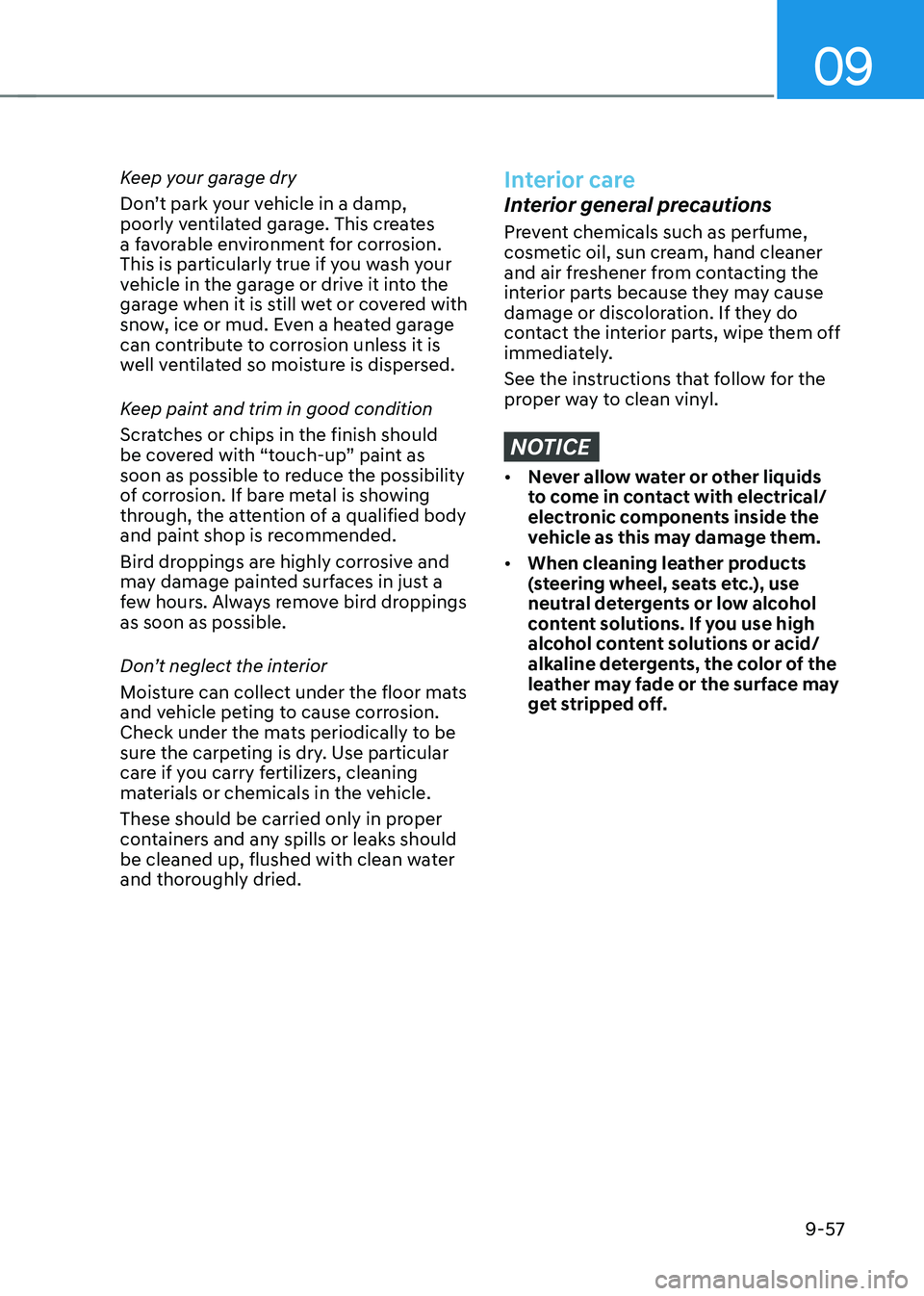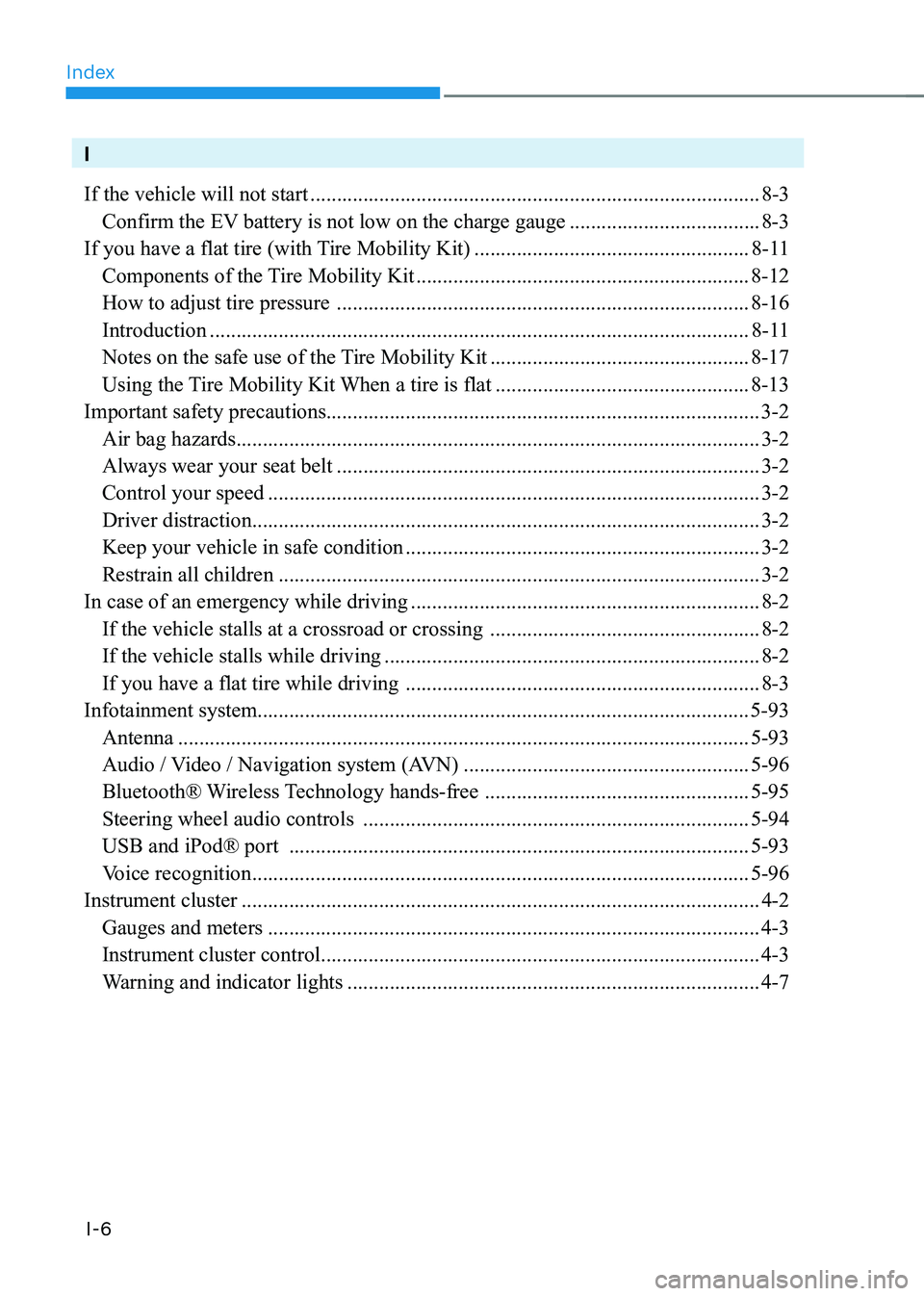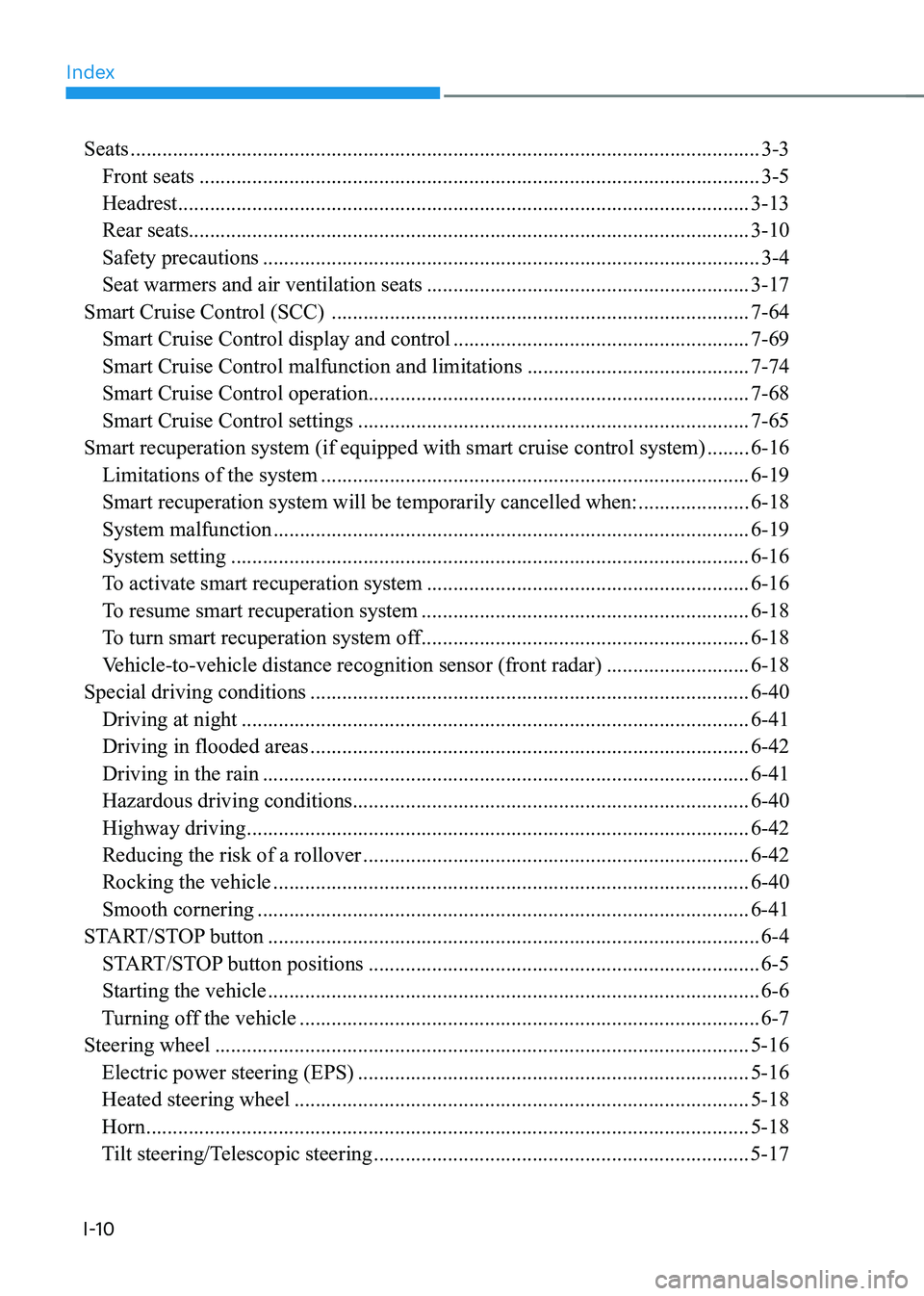2023 HYUNDAI KONA EV steering wheel
[x] Cancel search: steering wheelPage 499 of 548
![HYUNDAI KONA EV 2023 Owners Manual 09
9-23
Tire replacement
OLMB073027
A
[A] : Tread wear indicator If the tire is worn evenly, a tread wear
indicator will appear as a solid band
across the tread. This shows there is less
than 1.6 HYUNDAI KONA EV 2023 Owners Manual 09
9-23
Tire replacement
OLMB073027
A
[A] : Tread wear indicator If the tire is worn evenly, a tread wear
indicator will appear as a solid band
across the tread. This shows there is less
than 1.6](/manual-img/35/56170/w960_56170-498.png)
09
9-23
Tire replacement
OLMB073027
A
[A] : Tread wear indicator If the tire is worn evenly, a tread wear
indicator will appear as a solid band
across the tread. This shows there is less
than 1.6 mm (1/16 in.) of tread left on the
tire. Replace the tire when this happens.
Do not wait for the band to appear across
the entire tread before replacing the tire.
WARNING
To reduce the risk of DEATH or SERIOUS
INJURY: • Replace tires that are worn, show
uneven wear, or are damaged.
Worn tires can cause loss of braking
effectiveness, steering control, and
traction.
• Always replace tires with the same
size as each tire that was originally
supplied with this vehicle. Using
tires and wheels other than the
recommended sizes could cause
unusual handling characteristics,
poor vehicle control, or negatively
affect your vehicle’s Anti-Lock Brake
System (ABS) resulting in a serious
accident. •
When replacing tires (or wheels), it
is recommended to replace the two
front or two rear tires (or wheels)
as a pair. Replacing just one tire
can seriously affect your vehicle’s
handling. If only replacing one pair of
tires, it is recommended to install the
pair of new tires on the rear axle.
• Tires degrade over time, even when
they are not being used. Regardless
of the remaining tread, HYUNDAI
recommends that tires be replaced
after six (6) years of normal service.
• Heat caused by hot climates or
frequent high loading conditions can
accelerate the aging process. Failure
to follow this warning may cause
sudden tire failure, which could lead
to a loss of vehicle control resulting
in an accident.
Page 533 of 548

09
9-57
Keep your garage dry
Don’t park your vehicle in a damp,
poorly ventilated garage. This creates
a favorable environment for corrosion.
This is particularly true if you wash your
vehicle in the garage or drive it into the
garage when it is still wet or covered with
snow, ice or mud. Even a heated garage
can contribute to corrosion unless it is
well ventilated so moisture is dispersed.
Keep paint and trim in good condition
Scratches or chips in the finish should
be covered with “touch-up” paint as
soon as possible to reduce the possibility
of corrosion. If bare metal is showing
through, the attention of a qualified body
and paint shop is recommended.
Bird droppings are highly corrosive and
may damage painted surfaces in just a
few hours. Always remove bird droppings as soon as possible.
Don’t neglect the interior
Moisture can collect under the floor mats
and vehicle peting to cause corrosion.
Check under the mats periodically to be
sure the carpeting is dry. Use particular
care if you carry fertilizers, cleaning
materials or chemicals in the vehicle.
These should be carried only in proper
containers and any spills or leaks should
be cleaned up, flushed with clean water
and thoroughly dried.
Interior care
Interior general precautions
prevent chemicals such as perfume,
cosmetic oil, sun cream, hand cleaner
and air freshener from contacting the
interior parts because they may cause
damage or discoloration. If they do
contact the interior parts, wipe them off
immediately.
See the instructions that follow for the
proper way to clean vinyl.
NOTICE
•
Never allow water or other liquids
to come in contact with electrical/
electronic components inside the
vehicle as this may damage them.
• When cleaning leather products
(steering wheel, seats etc.), use
neutral detergents or low alcohol
content solutions. If you use high
alcohol content solutions or acid/
alkaline detergents, the color of the
leather may fade or the surface may
get stripped off.
Page 541 of 548

Index
I-6
I If the vehicle will not start ..................................................................................... 8-3
Confirm the EV battery is not low on the charge gauge ....................................8-3
If you have a flat tire (with Tire Mobility Kit) ....................................................8-11
Components of the Tire Mobility Kit ............................................................... 8-12
How to adjust tire pressure .............................................................................. 8-16
Introduction ...................................................................................................... 8-11
Notes on the safe use of the Tire Mobility Kit .................................................8-17
Using the Tire Mobility Kit When a tire is flat ................................................8-13
Important safety precautions.................................................................................. 3-2
Air bag hazards ................................................................................................... 3-2
Always wear your seat belt ................................................................................ 3-2
Control your speed ............................................................................................. 3-2
Driver distraction ................................................................................................ 3-2
Keep your vehicle in safe condition ................................................................... 3-2
Restrain all children ........................................................................................... 3-2
In case of an emergency while driving .................................................................. 8-2
If the vehicle stalls at a crossroad or crossing ...................................................8-2
If the vehicle stalls while driving ....................................................................... 8-2
If you have a flat tire while driving ................................................................... 8-3
Infotainment system............................................................................................. 5-93 Antenna ............................................................................................................ 5-93
Audio / Video / Navigation system (AVN) ......................................................5-96
Bluetooth® Wireless Technology hands-free ..................................................5-95
Steering wheel audio controls ......................................................................... 5-94
USB and iPod® port ....................................................................................... 5-93
Voice recognition .............................................................................................. 5-96
Instrument cluster .................................................................................................. 4-2
Gauges and meters ............................................................................................. 4-3
Instrument cluster control ................................................................................... 4-3
Warning and indicator lights .............................................................................. 4-7
Page 545 of 548

Index
I-10Seats
....................................................................................................................... 3-3
Front seats .......................................................................................................... 3-5
Headrest ............................................................................................................ 3-13
Rear seats .......................................................................................................... 3-10
Safety precautions .............................................................................................. 3-4
Seat warmers and air ventilation seats .............................................................3-17
Smart Cruise Control (SCC) ............................................................................... 7-64
Smart Cruise Control display and control ........................................................7-69
Smart Cruise Control malfunction and limitations ..........................................7-74
Smart Cruise Control operation ........................................................................ 7-68
Smart Cruise Control settings .......................................................................... 7-65
Smart recuperation system (if equipped with smart cruise control system) ........6-16
Limitations of the system ................................................................................. 6-19
Smart recuperation system will be temporarily cancelled when: .....................6-18
System malfunction .......................................................................................... 6-19
System setting .................................................................................................. 6-16
To activate smart recuperation system .............................................................6-16
To resume smart recuperation system ..............................................................6-18
To turn smart recuperation system off ..............................................................6-18
Vehicle-to-vehicle distance recognition sensor (front radar) ...........................6-18
Special driving conditions ................................................................................... 6-40
Driving at night ................................................................................................ 6-41
Driving in flooded areas ................................................................................... 6-42
Driving in the rain ............................................................................................ 6-41
Hazardous driving conditions ........................................................................... 6-40
Highway driving ............................................................................................... 6-42
Reducing the risk of a rollover ......................................................................... 6-42
Rocking the vehicle .......................................................................................... 6-40
Smooth cornering ............................................................................................. 6-41
START/STOP button ............................................................................................. 6-4
START/STOP button positions .......................................................................... 6-5
Starting the vehicle ............................................................................................. 6-6
Turning off the vehicle ....................................................................................... 6-7
Steering wheel ..................................................................................................... 5-16
Electric power steering (EPS) .......................................................................... 5-16
Heated steering wheel ...................................................................................... 5-18
Horn .................................................................................................................. 5-18
Tilt steering/Telescopic steering ....................................................................... 5-17